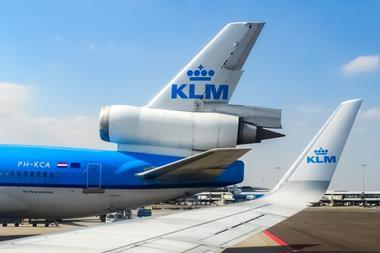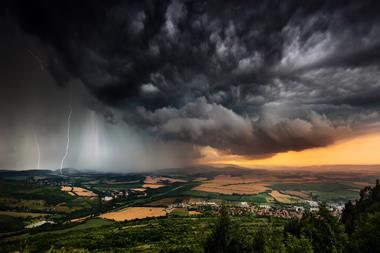Extreme weather conditions and natural or man-made disasters usually cause a blip in commodity prices. How big a shift and how long it lasts depend on many factors. By Hugh Craig and Lee Coppack
Supply and demand fundamentals and long-term investment strategies, for instance by hedge funds, determine the value of raw materials from cocoa to crude oil. The ability to substitute one commodity for another, lead times for capital investment in new mines, availability and cost of freight, government policies, health scares and consumer taste are also significant factors.
Michael Hughes, chief investment officer of Baring Asset Management, noted in June 2006 the impact on investment of extreme weather such as hurricanes, floods and drought. Speaking at an IRC investment conference in London, he saw a risk of spikes in commodity prices as a result of extreme weather, and also of a rise in insurance premiums.
So just how momentous is a hurricane in the Gulf of Mexico, a heatwave in France or the wreck of an ageing container vessel on an English beach?
Before Hurricane Katrina in August 2005, commodity prices from oil and gas, steel and copper, to coffee and grain were near or at historic highs thanks to elevated global demand and political concerns.
In the immediate aftermath of Katrina, Gulf of Mexico oil production was reduced by about 91.5% of daily production of 1.5 million barrels per day, according to the US government's Minerals Management Service (MMS). The MMS also reported that nearly 84% of the 10 billion cubic feet per day of natural gas production was shut in.
There was extensive damage to offshore structures, pipelines and onshore facilities including refineries. Together with Hurricane Rita less than a month later, Katrina caused an estimated $38 billion energy related losses from the Gulf, of which about $10 billion was insured, according to the catastrophe modeller EQECAT, which has just released a new onshore and offshore Gulf energy model.
The resulting shortages, speculation and continuing political issues pushed up the price of crude oil for the following eight months. On 18 April 2006, domestic sweet light crude for June delivery settled at $75.17 per barrel, after hitting a record intraday high of $75.35. Natural gas prices also reached unprecedented highs with the price per 1,000 cubic feet peaking at $10.35 in December 2005. A release of oil from the US strategic petroleum reserve probably prevented an even higher spike.
Mid-term forecasts issued in May 2006 prompted predictions that if even one of the nine hurricanes predicted for the coming season were to wreak the havoc of Katrina, Rita or 2004's Ivan in the Gulf, oil prices would probably spike above the record prices set in April 2006. "We're still living in a disrupted world," said Guy Caruso, administrator of the US Energy Information Administration, at a Houston, Texas, energy conference in early 2006.
In the event, the unexpectedly benign hurricane season meant there were no further storm induced cuts to oil and gas production, and Gulf producers were able to restore infrastructure and production. In February 2007, crude was steady at around $60 a barrel. Political tension in the Middle East, production policy by the OPEC oil cartel, supply glitches by non-OPEC producer Russia, moves to nationalise mineral resources in Venezuela and attacks on oil companies operating in the Nigerian Delta were all more likely to have influenced the price per barrel than the mild northern hemisphere winter.
Products and metals
The US Gulf region is also home to some important chemical production centres, As a result of Katrina, DuPont suffered extensive flooding at its DeLisle, Mississippi plant, which is responsible for 19% of US and 7% of global production capacity for the pigment titanium dioxide.
Although facilities belonging to Texas based chemical manufacturer Huntsman were undamaged, the company raised list prices for many of its performance specialties, including titanium dioxide on 15 September 2005, or as soon as contracts allowed, to reflect "the escalation of raw material and energy costs due to the effects of Hurricane Katrina."
On 30 September, Huntsman announced a further increase of in the price of titanium oxide, and DuPont and other producers followed suit the following day. Prices continued to rise during 2006 as a result, stated Huntsman, "of ongoing, significant raw material, energy and freight cost increases."
Precious and base metals prices, strong after a two year bull run, are generally more vulnerable to politics, strikes and macroeconomic factors than to natural catastrophes.
True, there were short lived price blips over the condition of London Metal Exchange (LME) grade zinc in New Orleans warehouses after Katrina, and even on a report, which proved incorrect, that the containership Napoli was carrying 1,100 tonnes of nickel when it foundered in high seas during windstorm Kyrill off southwest England in January 2007.
These tend to be "Monday morning," one-off and short lived wonders, the result of some traders reaching for the nearest plausible news item to illustrate an underlying trend or fundamental market imbalance.
Weather market
Like farmers, traders in grains often talk about a weather market, in which extremes of weather determine prices at least for the short term. One example was in Europe in July 2006 when grain prices jumped more than 10 euros per tonne as traders and speculators bet on more crop damage in France's main wheat belt north of Paris.
November wheat futures traded in Paris hit a contract high of 132 euros a tonne on initial disappointing yield reports as the harvesters rolled north. Behind the blip was a calculation that a repeat of the 2003 heatwave could be underway.
In July 2003, November wheat had traded just above 120 euros a tonne, but within a few months, the benchmark March contract had soared to just below 170 euros as grain supplies tightened across Europe. In 2006, prices eased, with November wheat back to around 127 euros.
In August 2006, the worst drought for 50 years in southwest China led to the loss of 5 million tonnes of grain and contributed to higher prices for vegetables, poultry and pork. The prolonged Australian drought pushed wheat prices on the Chicago Board of Trade (CBOT) to a 10 year high on 12 October 2006 over fears that the country's production would be halved.
Florida's $9.1 billion citrus industry, devastated by three consecutive hurricanes in 2004, was further battered by Hurricane Wilma in 2005. The storms also spread citrus canker, a disease that causes oranges and grapefruit to drop prematurely, severely denting the state's output.
Partly on jitters over more hurricanes to come, the frozen juice market in New York rallied to its highest level in 14 years, with the July frozen concentrated orange juice contract at the New York Board of Trade surging to a lifetime peak of 165 cents per pound. Prices later retreated after commodity funds took profits on their gains, but raw materials prices sometimes go up and stay up.
Timber
Catastrophic shocks to existing stocks of a renewable resource can cause long term local price shifts, according to a paper published in 2000 in the American Journal of Agricultural Economics. Researchers Jeffrey Prestemon and Thomas Holmes studied the price dynamics of timber following Hurricane Hugo, which damaged 20% of southern pine timber in the South Carolina Coastal Plain in 1989.
Their models revealed a 30% negative price spike due to salvage in the immediate aftermath of the storm and a long term enhancement effect, leading to prices between 10 and 30% higher than they would have been without Hugo.
Commenting on the effects of hurricanes Katrina and Rita, Steve Templin, president of the Louisiana based forestry consulting business, Templin Forestry, said such events affect the timber resource with breakage and blow-downs. "As you can imagine, there is often a run on lumber and plywood shortly after these events. Local supplies of building products may be in tight supply for a while until roads are cleared and commerce can get running effectively to restore supplies.
"The longer term consequences from these events are felt by the lessening of supply of timber in the affected areas. This does not affect national or international markets. However, a sawmill that was in the middle of the storm may now have to travel 40 to 50 miles in order to find commercial volumes of timber. This can affect the bottom line for manufacturing facilities," he explained.
It's an ill wind...
Substitution is always at the back of traders' minds when a commodity price goes through the roof, and the plain example is vanilla. The global price of the product, used to flavour ice cream, cakes and soft drinks, collapsed to $20 per kg in 2004 from a 2003 peak of $450 per kg, after industrial users facing spiralling costs switched to biotech substitutes. Prices also fell because the boom period encouraged new entrants, like Uganda and Mexico, increasing supply of the sweet smelling crop.
More recently, pests and bad weather reduced Vietnam's rice output, curtailing exports, but traders pointed out that Thailand would quickly answer any unrequited demand.
Commodity traders also look for hedging opportunities, and the growing number of traded catastrophe-related securities, such as catastrophe bonds and the new NYMEX cat risk index contracts, could be useful to them, especially in light of the February 2007 report by The Intergovernmental Panel on Climate Change (IPCC) that said that typhoons and hurricanes are likely to intensify in strength due to climate change.
Hugh Craig is the pseudonym of a commodities journalist.
Lee Coppack is editor of Catastrophe Risk Management.
Lee.coppack@cat-risk.com
www.cat-risk.com
This article has been compiled with the help of news stories on reuters.com.



















